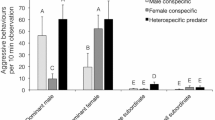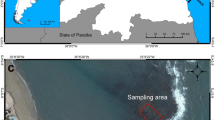Summary
The effects of territory quality on kin-biased territorial defence behaviour and fitness of juvenile rainbow trout (Oncorhynchus mykiss) were examined by manipulating food and predation risk levels in an artificial stream channel. Groups of related (full sibling) or unrelated fry were observed in the channel under one of four treatments: (1) high food-low predator (high territory quality); (2) high food-high predator; (3) low food-low predator; and (4) low food-high predator (low territory quality). Fish within kin groups always initiated fewer aggressive interactions, defended smaller territories, exhibited higher proportions of ‘threat’ type territorial defence behaviours (as opposed to ‘overtly aggressive’ behaviours) and had a higher mean weight increase than non-kin groups. Within both kin and non-kin groups, decreasing territory quality significantly increased the frequency of aggressive interactions, the size of territories and decreased growth. It is argued that while kin-biased territorial defence behaviours are always present, decreased availability of resources and increased predation risk serve to reduce the magnitude of this kin bias. However, even in low-quality territories, the benefit of associating with kin may increase the probability of overwintering survival (increased fitness) of the young fish by increasing body size.
Similar content being viewed by others
References
Abbott JC, Dill LM (1985) Patterns of aggressive attack in juvenile steelhead trout (Salmo gairdneri). Can J Fish Aquat Sci 42:1702–1706
Abbott JC, Dunbrack RL, Orr CD (1985) The interaction of size and experience in dominance relationships of juvenile steelhead trout (Salmo gairdneri). Behaviour 92:241–253
Altmann J (1974) Observational study of behaviour: sampling methods. Behaviour 49:227–265
Armitage KB (1989) The function of kin discrimination. Ethol Ecol Evol 1:111–121
Barlow GW (1968) Ethological units of behaviour. In: Ingles D (ed) The central nervous system and fish behaviour. University of Chicago Press, Chicago, pp 217–232
Blaustein AR, Bekoff M, Daniels TJ (1987) Kin recognition in vertebrates (excluding primates): empirical evidence. In: Fletcher DJC, Michener CD (eds) Kin recognition in animals. John Wiley, Toronto, pp 287–332
Brown GE, Brown JA (1992) Do rainbow trout and Atlantic salmon discriminate kin? Can J Zool 70:1636–1640
Brown GE, Brown JA (1993) Social dynamics in salmonid fishes: Do kin make better neighbours? Anim Behav 45:863–871
Dill LM (1978) An energy-based model of optimal feeding-territory size. Theor Popul Biol 14: 396–429
Dill LM, Ydenberg RC, Fraser AHG (1981) Food abundance and territory size in juvenile coho salmon (Oncorhynchus kisutch). Can J Zool 59:1801–1809
Dill PA (1977) Development of behaviour in alevins of Atlantic salmon (Salmo salar) and rainbow trout (S. gairdneri). Anim Behav 25:116–121
Feldmeth CR (1983) Cost of aggression in trout and pupfish. In: Aspey WP, Listick SI (eds) Behavioural energetics: the cost of survival in vertebrates. Ohio State University Press, Columbus, pp 117–138
Gibson RJ (1981) Behavioural interactions between coho salmon (Oncorhynchus kisutch), Atlantic salmon (Salmo salar), brook trout (Salvelinus fontinalis), and steelhead trout (Salmo gairdneri) at the juvenile fluviatile stages. Can Tech Report Fish Aquat Sci 1029:1–116
Gotceitas V, Godin J-GJ (1991) Foraging under the risk of predation in juvenile Atlantic salmon (Salmo salar L.): Effects of social status and hunger. Behav Ecol Sociobiol 29:255–261
Gotceitas V, Godin J-GJ (1993) Effects of aerial and in-stream threat of predation on foraging by juvenile Atlantic salmon (Salmo salar L.). In: Gibson RJ, Cutting RE (eds) Production of juvenile Atlantic salmon,Salmo salar, in natural waters. Can Spec Publ Fish Aquat Sci 118:35–41
Grant JWA, Noakes DLG (1987) A simple model of optimal territory size for drift-feeding fish. Can J Zool 65:270–276
Grau HJ (1982) Kin recognition in white-footed deermice (Peromyscus leucopus). Anim Behav 30:497–505
Hamilton WD (1964) The genetic theory of social behaviour, I, II. J Theor Biol 7:1–52
Hutchings JA (1993) Behavioural implications of intraspecific life history variations. Mar Behav Physiol 23:187–203
Kalleberg H (1958) Observations in a stream tank of territoriality and competition in juvenile salmon and trout, (Salmo salar L. andS. trutta L.). Rep Inst Freshwater Res Drottingholm 39:55–98
Krebs JR, Davies NB (1981) An introduction to behavioural ecology. Sinauer Associates, Sunderland
Noldus (1990) The Observer. Noldus Information Technology, Wagenigen
Post JR, Evans DO (1989) Size-dependent overwinter mortality of young-of-the-year yellow perch (Perca flavescens): laboratory, in situ enclosure and field experiments. Can J Fish Aquat Sci 46: 1958–1968
Priede IG (1985) Metabolic scope in fishes. In: Tytler P, Calow P (eds) Fish energetics: new perspectives. Hohn Hopkins University Press, Baltimore, pp 33–64
Puckett KJ, Dill LM (1985) The energetics of feeding territoriality in juvenile coho salmon (Oncorhynchus kisutch). Behaviour 92:97–111
Reeve HK (1989) The evolution of conspecific acceptance thresholds. Am Nat 133:407–435
SAS Institute (1988) SAS/STAT user's guide, release 6.03 edn. SAS Institute Inc., Cary, North Carolina
Scott WB, Crossman EJ (1973) Freshwater fishes of Canada. Can Bull Fish Aquat Sci 184:1–966
Scott WB, Scott MG (1988) Atlantic Fishes of Canada. Can Bull Fish Aquat Sci 219:1–731
Siegel S (1956) Nonparametric statistics for the behavioural sciences. McGraw-Hill, New York
Slaney PA, Northcote TG (1974) Effects of prey abundance on density and territorial behaviour of young rainbow trout (Salmo gairdneri) in laboratory stream channels. J Fish Res Board Can 31: 1201–1209
Sokal RJ, Rohlf FJ (1981) Biometry. W.H. Freeman, San Francisco
Stringer GE, Hoar WS (1955) Aggressive behaviour in underyearling Kamploops trout. Can J Zool 33:148–160
Walls SC (1991) Ontogenetic shifts in the recognition of siblings and neighbours by juvenile salamanders. Anim Behav 42:423–434
Wilson EO (1975) Sociobiology. Belknap/Harvard, Cambridge
Wilson EO (1987) Kin recognition: an introductory synapsis. In: Fletcher DJC, Michener CD (eds) Kin recognition in animals. John Wiley, Chichester, pp 7–18
Wrangham RW (1982) Mutualism, kinship and social evolution. In: Kings College Sociobiology Group, Cambridge (ed) Current problems in sociobiology. Cambridge University Press, Cambridge, pp 269–289
Author information
Authors and Affiliations
Rights and permissions
About this article
Cite this article
Brown, G.E., Brown, J.A. Do kin always make better neighbours?: The effects of territory quality. Behav Ecol Sociobiol 33, 225–231 (1993). https://doi.org/10.1007/BF02027119
Received:
Accepted:
Issue Date:
DOI: https://doi.org/10.1007/BF02027119




